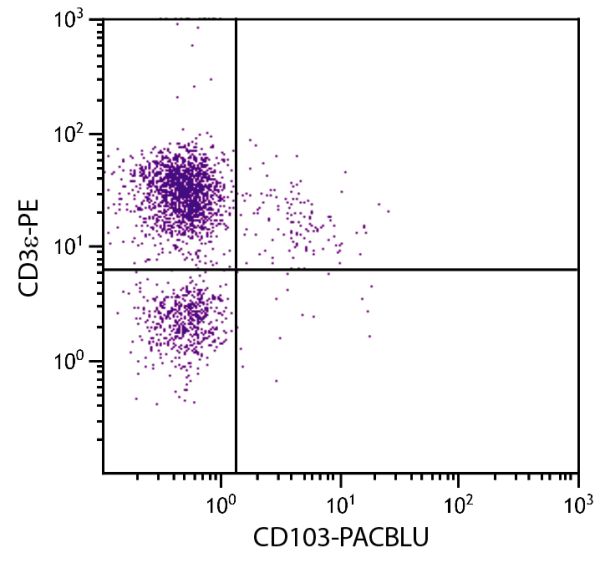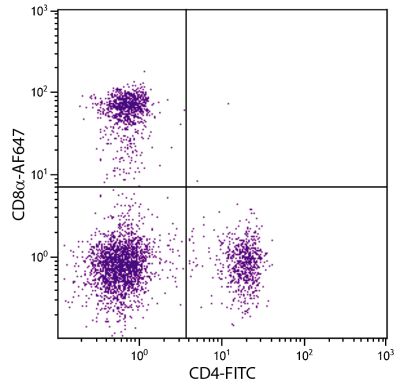Hamster Anti-Mouse CD103-PACBLU (2E7)
Cat. No.:
1810-26
Pacific Blue™ Anti-Mouse CD103 antibody for use in flow cytometry assays.
$230.00


| Clone | 20000000 |
|---|---|
| Isotype | Hamster (Armenian) IgG2 |
| Isotype Control | Hamster IgG-PACBLU |
| Specificity | Mouse CD103 |
| Alternative Names | Integrin αIEL, αE integrin, ITGAE |
| Description | CD103 is a member of the integrin series of adhesion molecules. This antigen defines a developmentally important subset of T cells, namely mucosal T cells including all IEL (intraepithelial lymphocytes) and ~20% of lamina propria T cells. Expression of CD103 is more restricted outside these mucosal organs appearing at lower levels on T cell subsets of the lymph node, dendritic epidermis, and periphery. In non-epithelial CD103+ T cells there is a bias toward expression on CD8+ cells. The 2E7 monoclonal antibody exhibits antigen immunoprecipitation patterns similar if not identical to the rat anti-mouse CD103 monoclonal antibody M290. 2E7 is reported to have signal-inducing activity in a redirected lysis assay and to costimulate IEL and CD8+ lymph node cells in conjunction with anti-TCR in vitro which runs counter to the usual inhibition of CTL by anti-integrins. This costimulatory activity is also shared by the monoclonal antibody M290. The property of costimulation is not unique to the mouse since the combination of anti-human αIEL plus anti-TCR will produce similar proliferation in human cells with the exception that CD8+ cells are not stimulated. |
| Immunogen | C57BL/6J mouse intestinal intraepithelial lymphocytes (IEL) |
| Conjugate | PACBLU (Pacific Blue™) |
| Buffer Formulation | Phosphate buffered saline containing < 0.1% sodium azide |
| Clonality | Monoclonal |
| Concentration | 0.5 mg/mL |
| Volume | 0.2 mL |
| Recommended Storage | 2-8°C; Avoid exposure to light |
| Trademark Information | Pacific Blue™ is a trademark of Thermo Fisher Scientific, Inc. or its subsidiaries |
| Applications |
Flow Cytometry – Quality tested 2 Immunoprecipitation – Reported in literature 2 Immunohistochemistry-Frozen Sections – Reported in literature 2 Activation – Reported in literature 3 |
| RRID Number | AB_2795381 |
| Gene ID |
16407 (Mouse) |
| Gene ID Symbol |
Itgae (Mouse) |
| Gene ID Aliases | A530055J10; CD103; aM290; alpha-E1; alpha-M290 |
| UniProt ID |
Q60677 (Mouse |
| UniProt Name |
ITAE_MOUSE (Mouse) |
Documentation
Certificate of Analysis Lookup
Enter the Catalog Number and Lot Number for the Certificate of Analysis you wish to view
- 1. Goodman T, Lefrancois L. Intraepithelial lymphocytes. Anatomical site, not T cell receptor form, dictates phenotype and function. J Exp Med. 1989;170:1569-81. (Immunogen)
- 2. Lefrançois L, Barrett TA, Havran WL, Puddington L. Developmental expression of the αIELβ7 integrin on T cell receptor γδ and T cell receptor αβ T cells. Eur J Immunol. 1994;24:635-40. (IP, IHC-FS, FC)
- 3. Müller S, Jungo M, Aichele P, Mueller C. CD5- CD8αβ intestinal intraepithelial lymphocytes (IEL) are induced to express CD5 upon antigen-specific activation: CD5- and CD5+ CD8αβ IEL do not represent separate T cell lineages. Eur J Immunol. 1997;27:1756-61. (Activ)




